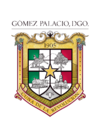Gómez Palacio, Durango facts for kids
Quick facts for kids
Gómez Palacio, Durango
|
||
|---|---|---|

Main Square of Gómez Palacio
|
||
|
||
| Nickname(s):
industrial capital of comarca lagunera
|
||
| Country | ||
| State | Durango | |
| Municipality | Gómez Palacio | |
| Population
(2010)
|
||
| • Total | 327,985 | |
| Website | Official website: http://www.gomezpalacio.gob.mx/ | |
Gómez Palacio is a city in northeastern Durango, Mexico. It's right next to the state of Coahuila. It's also the name of the area around the city, called a municipality. The city is named after Francisco Gómez Palacio y Bravo, who used to be the governor of Durango.
In 2010, the city of Gómez Palacio had about 327,985 people. This makes it the second-largest community in Durango. The municipality, which includes the city and its surrounding areas, had the same population. The municipality covers about 990.2 square kilometers. Gómez Palacio is part of a bigger area called the Comarca Lagunera Metropolitan Area. This large area also includes cities like Torreón and Matamoros in Coahuila, and Lerdo in Durango. In 2010, this whole metropolitan area had over 1.2 million people.
Contents
How Gómez Palacio Began
A long time ago, in the 1600s, the land where Gómez Palacio now stands was part of a large property. It was called Hacienda de San Lorenzo de la Laguna.
Later, in 1848, a man named Juan Ignacio Jimenez bought these lands. He built a dam and a system of canals. These canals helped bring water from the Nazas River to irrigate the farms in the area.
The City's Founding
In 1880, Santiago Lavín Cuadra, a Spanish farmer, bought these properties. In 1885, Lavín started planning the city. He created a public square and offered free land to people. The only condition was that they had to plant trees. This was to make the area look different and greener.
The very first land deed was recorded on September 15, 1885. This date is now celebrated as the city's founding day. Lavín named the town after Francisco Gómez Palacio. He did this to honor Gómez Palacio's many achievements. He was a governor, a federal deputy, and even worked for the government of Benito Juárez.
The state government officially recognized Gómez Palacio as a city on December 21, 1905.
Early Businesses and Growth
In 1887, a company called La Jabonera (The Soap Factory) was started. It became one of the most important industries in the city. Another big company was La Amistad (Friendship), which made textiles. There was also La Union (The Union), a shoe factory. This factory became so successful that its shoes could compete with expensive brands from Europe and the U.S.
The Railroad's Impact
When the city was founded, Santiago Lavín Cuadra gave land to the Mexican Central Railroad. This allowed the railroad to build a roundhouse and workshops. The goal was to make Gómez Palacio a major railroad center. In 1907, a U.S. company moved its railroad facilities here. This created terminals for both passenger and cargo trains.
About 2,000 workers came to the city because of the railroad. At first, American workers operated the trains. But they trained Mexican workers, who slowly took over all the jobs. By 1910, Mexican workers filled all the positions.
Gómez Palacio became one of the biggest railroad centers in Mexico. This helped the city grow even more. However, during the Mexican Revolution, many businesses closed. This greatly affected the workers. For many years, the railroad was the main support for the local economy. Later, the railroad's main facilities moved to Torreon, Coahuila.
Modern Economy
In 1930, the Francke power plant was built. This gave a big boost to industrialization in the city.
Today, Gómez Palacio has a very active economy. It contributes almost 45% of the GDP (the total value of goods and services produced) for the Durango region, along with Ciudad Lerdo. If you include the entire Laguna Region of Durango, it contributes over 55%.
Gómez Palacio has several industrial parks. These include the newer Park Gómez Palacio Americas and Harrier Industrial Park, which has 588 companies. There's also the Zone of International Connectivity, Laguna, which helps with international trade.
Famous People from Gómez Palacio
- Manuel Banuelos: A baseball pitcher who played for four different teams in Major League Baseball.
- Uriel Antuna: A professional footballer.
- Andrade El Idolo: A professional wrestler.
Sister City
Gómez Palacio has one sister city:
 - South El Monte, California, USA
- South El Monte, California, USA
See also
 In Spanish: Gómez Palacio para niños
In Spanish: Gómez Palacio para niños





